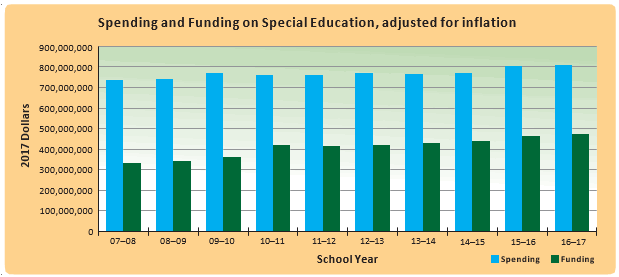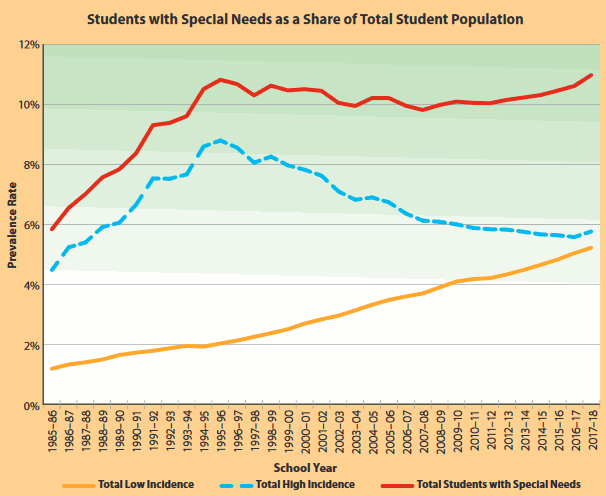For years, British Columbia has been allocating far less money for special education to school districts than districts have been spending on special education. Meaningful inclusion for all students requires a broad array of supports—specialist teachers, educational assistants, learning resources, specialized equipment and more. There in turn require adequate financial resources. By underestimating how much school districts need for special education, the provincial government is making inclusion more difficult and forcing school districts to make tough decisions: should special education suffer or should cuts be made elsewhere to compensate?
A persistent gap
In 2016-17, the last school year for which we have audited spending data, the funding flowing from the Ministry of Education to school districts for special education covered just 58 per cent of what school districts ultimately spent on special education—a shortfall of $328 million. Looking back, the average gap between funding and spending from 2007 to 2017 has been even larger: school districts received in special education grants on average 53 per cent of what they spent on special education in each of those ten years.

.gif?sfvrsn=f0c9e7a0_2)
The sizeable and persistent province-wide gap conceals some significant variation and inequity between school districts. While no school district was allocated sufficient special education funding to cover its total special education spending in 2016-17, 16 districts received less than half of what they spent on special education, and four received under 40 per cent. Most of these 16 are among the less populous, more rural and remote of BC’s school districts, where prevalence rates of special needs tend to be higher. Larger, urban districts, on the other hand, tend to have gaps in funding in percentage terms closer to the average, but this leaves them tens of millions of dollars short of what they end up spending because their budgets are much larger.

Who is funded?
One significant reason for the persistent gap between funding and spending for special education is a policy decision made by the Ministry of Education not to allocate funding for so-called “high incidence” categories of special needs. Currently, districts receive no additional funding from the Ministry for students with mild intellectual disabilities, learning disabilities, moderate behaviour issues, moderate mental illness or for those who are gifted.
While the share of children with special needs designations has been relatively stable at between 10 and 11 per cent of the school-age student population since the late 1990s, the distribution between “low incidence” and “high incidence” designations has shifted. In 2000, “high incidence” designations were 7.8 per cent of the total student population and “low incidence” designations accounted for just 2.7% of the total. In the past school year, 2017-18, the split was 5.8 per cent for “high incidence” and 5.2 per cent for “low incidence”.
There are many factors that have impacted these shifts between designations, including a greater awareness of many special needs, better parent advocacy and shifts in diagnostic criteria. However, it is likely that changes in funding and in particular the removal of funding for “high incidence” designations as part of the 2002 reform of the provincial K-12 education funding formula has contributed to the changes in how children are designated—in addition, of course, to being a root cause of the gap itself.
It is important to remember that students with “high incidence” designations also require support from the school system. In fact, simply because a need is more prevalent in the population does not automatically mean that it requires less support than one that is more rare. All students should receive the full support generated by their particular needs and this means that all students with special needs should be allocated additional funding to enable those needs to be met.
Two models of funding special education
The design of the funding formula used by the provincial Ministry of Education to distribute funds between school districts can also help explain patterns in funding for special education.
Current block funding
British Columbia’s existing funding formula for public education is centered on per-pupil funding. About four-fifths of all money allocated to school districts for operating expenditures is proportional to their full-time equivalent (FTE) student enrolment in a given year. Supplementary funding for inclusive education, which makes up about one-tenth of all operating funding, is also allocated based on enrolment. There are three types of per-student (here based on a simple headcount, not FTE) funding:
- a Level 1 amount, the highest for students designated as Physically Dependent or Deafblind,
- a Level 2 amount for students designated as having Moderate to Profound Intellectual Disabilities, a Disability/Chronic Health Impairment, a Visual Impairment, Autism Spectrum Disorder or are Deaf or Hard of Hearing, and
- a Level 3 amount, the lowest, for students who are designated under Intensive Behaviour Intervention/Serious Mental Illness.
Currently, all money distributed under the funding formula, which amounts to nearly all operating funding, is “block funding” from the Ministry of Education to school districts. The Ministry puts no conditions on how any portion is spent. This means that special needs designations play a purely allocative role for the purposes of funding: they are used to calculate the amount of special education funding each district receives but do not tie funding amounts to particular students or supports.
As noted above, the allocations for special education cover barely over half of what districts spend on special education services. In addition, all three levels of per-student funding amounts have fallen by five per cent in inflation-adjusted terms since 2010-11 because they have not been adjusted upwards sufficiently over time.
Statistical predictive funding
In 2017, the new British Columbia government announced a review of the funding formula for public education. The final report of the panel tasked with this review is yet to be released but it is nearly certain significant changes are coming. A discussion paper released by the panel in the spring of 2018 focused on several potential far-reaching changes, with inclusive education one key area for change. The paper asked, “Should an alternative, non-diagnosis (or reporting-based) model of funding students with special needs be considered?”
To see what answering this question in the positive would look like in practice, we can look to other jurisdictions. One increasingly common reform of funding for inclusive education has been to base allocation on statistical prediction of the prevalence of special needs, rather than actual student designations.
Other provinces, such as Ontario or Nova Scotia, already use statistical modelling to allocate funding for inclusive education. A common way to do this is to use existing prevalence data (which can come from national or international statistics, or numbers of students identified at some point in the past) to distribute funding to school districts. These general prevalence rates are fed into a predictive model that uses district-level demographic and other information (income levels, parental education levels, etc.) to predict district-specific prevalence. Ontario uses this model to allocate 37% of inclusive education funding; the other part comes from a universal per-pupil amount that can only be spent on special education.
What's next for special education funding in BC?
It is difficult to say how British Columbia’s funding model for inclusive education will evolve; however, it is clear that whatever direction reform takes, it will have a very large impact on the shape and sustainability of inclusive education itself. The current situation, where districts are forced to make up large funding shortfalls for inclusive education from the province, is clearly untenable. The gap between funding allocated for special education and actual spending on special education services is one major reason for the slow erosion of these services.
And while there is both a need for more supportive and better resourced inclusion and a risk of over-medicalization of special needs, there are also clear dangers in delinking funding from identified student needs. Analytically, the problem with a statistical-predictive model is that it is a “black box”: there is no certainty that the funding outputs reflect the real needs of particular districts nor that the prevalence inputs reflect the real needs of the student population.
Translated into practice, there are several key risks when this black box is applied to education financing:
- the lack of a link between particular students and funds creates even greater pressures to ration funds and the potential for students with needs to fall through the gaps—when funding isn’t targeted, kids lose and teachers burn out;
- depending on how good the predictive model is, there is greater or lesser potential for there to be winner and loser districts, some with more funding than required, some with less; and
- a significant portion of identification will stop happening if districts don’t need to identify students to get funding; however, parents with the means to get identifications will do so and drive services to their children, potentially perpetuating inequities.
Reflecting on the impact of Ontario’s transition to a predictive model, economist Hugh Mackenzie summarizes these concerns well: “The breaking of the link between funding and needs has had profound implications for students, parents, teachers and special education administrators. For students and parents, there is no longer a link between needs and funding that can serve as a guide to available services. For teachers, there is no longer any link between special education needs identified in a classroom setting and additional resources to address those needs. The role of special education administrators has been transformed from one of enabling access to needed services to a gatekeeping role of rationing scarce resources and cost containment.”
To build a truly inclusive K-12 education system in British Columbia, we will have to dedicate sufficient resources and identify the needs that these resources should be targeted to meet.